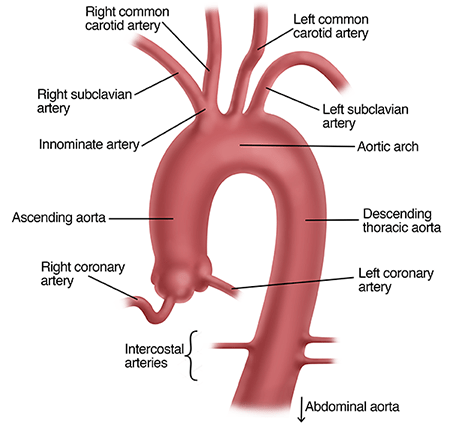Abdominal Aortic Aneurysm Treatment
The main treatment goal for an aortic aneurysm is early diagnosis in order to prevent rupture. Less than 50 percent of people survive a ruptured abdominal aortic aneurysm, so prevention is by far the best way to treat this condition.
The UPMC Heart and Vascular Institute offers a full range of state-of-the-art treatment strategies for abdominal aortic aneurysms.
We create a customized treatment plan, which includes an assessment of:
- The location of the aneurysm and how extensive the disease is.
- The size of the aneurysm.
- Your overall health, including a focused evaluation of your heart, kidneys, and lungs.
Based on our findings, we may recommend one of the following treatment options:
Aneurysm is small — less than 5-5.5 centimeters (about 2 inches)
- Duplex ultrasound scan every six to 12 months to assess the aneurysm's size.
- Lifestyle changes, such as quitting smoking.
- Medication to lower your blood pressure if your blood pressure is high.
- Medication to lower your cholesterol and reduce inflammation.
- Regular follow-up visits to closely monitor the abdominal aortic aneurysm.
Aneurysm is large — more than 5-5.5 centimeters (about 2 inches)
- At this size, the risk of rupture is still low, but if the aneurysm continues to grow, the risk will rapidly increase.
- Surgery is often recommended at this size and may be either minimally invasive or traditional to repair the aneurysm before it ruptures.
Our experience in treating abdominal aortic aneurysms
UPMC’s highly skilled vascular surgeons — who are among the nation's most experienced — routinely treat abdominal aortic aneurysms.
The goal of aneurysm treatment is to replace the aorta with a man-made graft. This redirects the blood flow through the graft and away from the weakened aneurysm wall, preventing the aneurysm from getting bigger. This also prevents the aneurysm from rupturing. After the repair, the aneurysm will usually shrink over time.
Our experts are able to offer the widest variety of surgical treatments ranging from traditional surgery to the most complex minimally invasive techniques available. The main treatments for abdominal aortic aneurysms include:
- Minimally invasive endovascular aneurysm repair (EVAR).
- Traditional (open) surgery.
- “Hybrid" procedures, combining open surgery, surgical repair, and minimally invasive techniques.
Our surgeons typically advise surgery when:
- The aneurysm reaches approximately five centimeters (about two inches) in diameter.
- Smaller aneurysms exist that cause symptoms or grow rapidly.
However, these are general guidelines, and each patient is different. Your vascular surgeon will discuss your individual risks and benefits of surgery and come to a decision together with you about whether to wait or to undergo a repair.
Endovascular aneurysm repair (EVAR)
The majority of abdominal aortic aneurysms can be repaired with a minimally invasive EVAR procedure. In contrast to a traditional “open" surgery, no big incisions are made in the abdomen. Instead, the arteries in the groins are accessed either by a needle puncture or a small incision.
A metal and fabric stent is then inserted into the groin punctures, through the arteries to the aneurysm. The stent is initially collapsed in order to travel through the blood vessels. Once it reaches the aneurysm, it is expanded and sits tightly against the wall of the aorta, relining the weakened portion. This redirects the blood flow through the stent and relieves the pressure on the weakened areas of the aorta.
After an EVAR, most people recover quickly and can often go home the next day. However, because the stent can shift over time, yearly follow-ups with your surgeon are required.
EVAR vs. traditional open abdominal aortic aneurysm repair:
- Reduces your hospital stay to two or three days.
- Requires less recovery time.
- Requires more frequent follow-up visits and imaging studies to ensure that the graft continues to function properly.
- May require periodic maintenance procedures.
Whether or not you can receive an EVAR depends on the shape, location, and extent of the aneurysm.
Of those who may not be a good fit for a regular EVAR, other minimally invasive options are often available as the UPMC Division of Vascular Surgery participates in many trials of cutting-edge devices to treat complex aortic aneurysms.
Traditional (open) surgery for abdominal aortic aneurysms
UPMC vascular surgeons are also experts in traditional open aneurysm repair. This may be suggested by your surgeon if your aneurysm's characteristics are not ideal for an EVAR or if he or she believes that you may benefit from long-term durability of an open repair.
In open surgical aneurysm repair, your vascular surgeon makes a long incision in your abdomen to get to the aorta. The surgeon then removes the weakened portion and replaces it with a fabric graft. This is a more invasive surgery, and the hospital stay is usually five to seven days.
Recovery time is six weeks to three months for a complete recovery, depending on your circumstances.
Many open aneurysm repairs are successful for the long term with few complications. Follow-up after open aneurysm repair is less frequent than that for EVAR, with most patients coming back every two to three years for a checkup.
Learn More About Abdominal Aortic Aneurysm Treatments
From our Health Library at UPMC.com



















